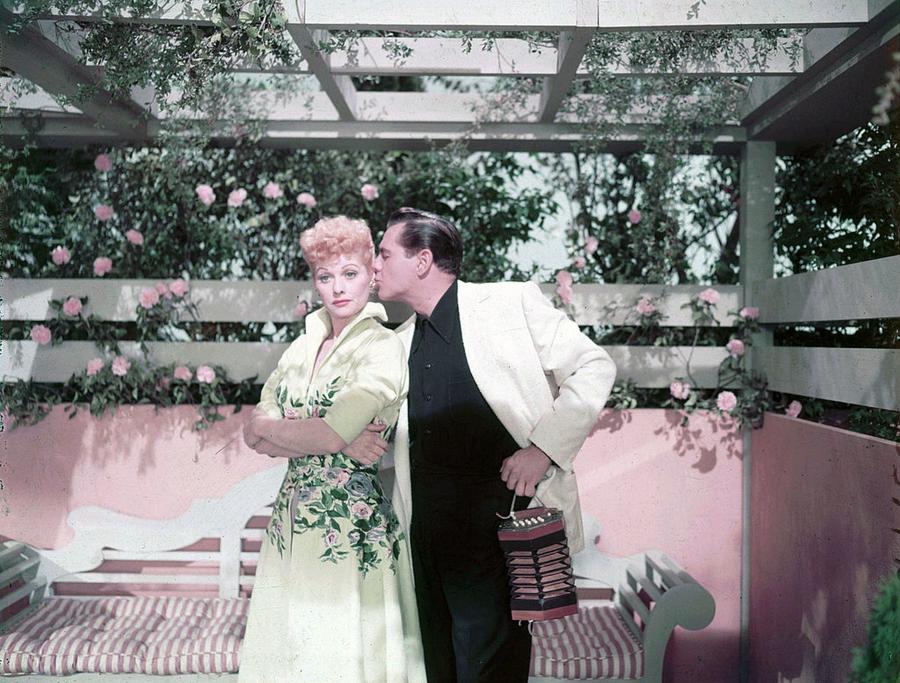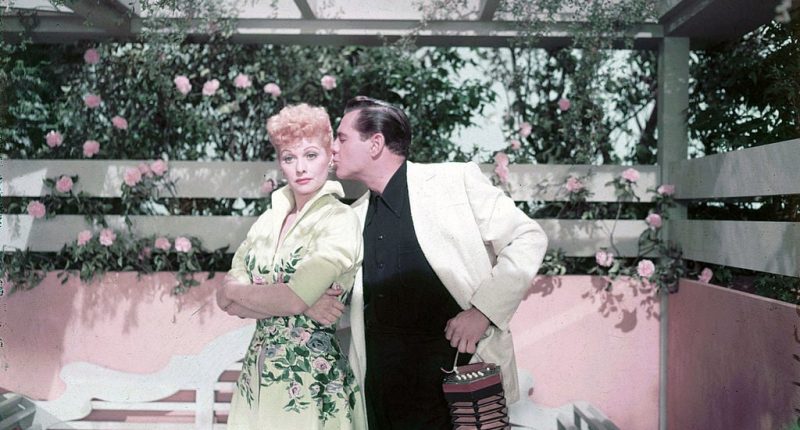Share this @internewscast.com
Lucille Ball didn’t just make people laugh—she changed the rules of television.
In 1950, network executives dismissed her idea of starring in a show with her Cuban-born husband. In 1951, she was the biggest star on television. By the time she sold her company in 1967, she was one of the richest and most powerful women in entertainment history.
Long before streaming, reruns, and binge-watching became billion-dollar industries, Lucille Ball understood one simple, powerful truth: ownership creates generational wealth. Thanks to one bold, high-stakes deal she made for “I Love Lucy,” Lucy didn’t just cement her legacy—she built a media empire that still exists today.

(Getty Images)
From Radio Star to Reluctant Trailblazer
Lucille Ball was born on August 6, 1911, in Jamestown, New York. Her father died of typhoid fever when she was just three, and the family struggled financially. At 15, Lucy enrolled in the John Murray Anderson School for the Dramatic Arts in New York City—the same school Bette Davis attended—but her instructors weren’t impressed. One reportedly told her she “had no future as a performer.” Undeterred, she began modeling for Hattie Carnegie and eventually worked as a Chesterfield cigarette girl.
In the 1930s, Lucy moved to Hollywood and began landing roles as a contract player for RKO Pictures. She was dubbed the “Queen of the B-Movies” due to her frequent appearances in modest-budget films like “The Affairs of Annabel” and “Dance, Girl, Dance.”
Meanwhile… Desi Arnaz was born Desiderio Alberto Arnaz y de Acha III on March 2, 1917, in Santiago de Cuba. His family was part of Cuba’s wealthy elite—his father was the mayor of Santiago and a member of the Cuban House of Representatives. But after the Cuban Revolution of 1933, the family fled to Miami, essentially starting over. Desi worked odd jobs and eventually broke into music as a conga-playing heartthrob with the Xavier Cugat Orchestra. By his early twenties, he had formed his own band, introduced the conga line to America, and become a fixture in Hollywood’s nightclub scene.
Too Many Girls
In 1940, Lucille Ball landed a role in RKO’s new college musical “Too Many Girls,” a lighthearted adaptation of a successful Broadway show. Lucy played the film’s leading lady, Connie Casey, a wealthy young heiress who enrolls at a small college to escape her overprotective family. Unbeknownst to her, her father hires a group of football-playing bodyguards to secretly follow and protect her, one of whom was played by a young Cuban bandleader named Desi Arnaz.
For Desi, “Too Many Girls” was his first major film appearance. He had originated the same role—Manuelito, the charming, music-loving athlete—on Broadway, where he had become known not just for his conga drumming but for his charisma on stage. Though the part wasn’t a dramatic showcase, it was a breakthrough opportunity that introduced him to Hollywood and American film audiences. He brought the same easy swagger, thick accent, and musical talent to the screen, and even performed several numbers in the film, including a standout conga performance that became his signature.
The movie itself wasn’t a massive box office smash, but it was a moderate success, and far more significant for what happened off-screen than on. Lucille and Desi met for the first time on set. Sparks flew immediately. Lucy, by then in her late 20s and a well-established contract player with more than 50 film credits, was intrigued by Desi’s energy and confidence. He was just 23, handsome, fast-talking, and full of charm.
Within a few months of wrapping the film, they eloped. Their passionate and, at times, tumultuous relationship would span two decades, two children, and one of the most groundbreaking shows in television history. Years later, Lucy would quip about the movie: “It wasn’t a particularly good picture, but it did something for me. It gave me Desi.“
A Marriage Under Pressure, and a Career Pivot
Despite the whirlwind romance, married life for Lucille and Desi was anything but smooth. The early years of their marriage were marked by constant separation—Desi was always on the road with his orchestra, performing in nightclubs and ballrooms across the country, while Lucy remained in Hollywood shooting movies. Their opposite schedules strained the relationship. Lucy wanted to settle down and start a family; Desi, meanwhile, was still living the fast-paced life of a touring musician.
By the late 1940s, Lucy’s movie career had cooled, and she was looking for new opportunities. That’s when CBS approached her about adapting her successful radio show, “My Favorite Husband,” into a television series. The radio show, which premiered in 1948, had become a hit thanks to Lucy’s brilliant comedic timing and relatable housewife character, Liz Cooper.
Lucy agreed to make the leap to television—but only if Desi could play her on-screen husband. CBS balked. Executives didn’t think American audiences would accept a red-haired American woman married to a Cuban man. They pushed for a more conventional casting choice.
But Lucy stood her ground. If she was going to do television, she was going to do it with Desi. To prove they could win over audiences together, the couple developed a vaudeville act and took it on the road. The show featured physical comedy, musical numbers, and their natural chemistry. Audiences went wild.
The tour’s success made CBS reconsider. They greenlit a new sitcom—starring both Lucy and Desi—under one condition: Lucy and Desi would pay for the production upgrades they insisted on. That’s when Lucy and Desi made one of the smartest business decisions in television history.
The Deal That Changed Television Forever
Back in the early 1950s, most television shows were broadcast live from New York, with grainy, low-quality kinescope recordings used for delayed broadcasts elsewhere. Lucy and Desi, however, wanted to film “I Love Lucy” in Hollywood using 35mm film to ensure high-quality footage for national distribution.
CBS didn’t want to foot the bill for the new filming process. So Lucy and Desi made a bold offer: They would take a pay cut and personally cover the production costs—on one condition: they would own the filmed episodes outright.
At the time, no one thought old episodes of a sitcom would ever be worth much. But Lucy and Desi understood the long tail. Syndication was in its infancy, but they saw the future. And when “I Love Lucy” became the biggest show in the country, they weren’t just the stars—they were the owners.
The show premiered on October 15, 1951. It was an instant sensation. At its peak, “I Love Lucy” drew more than 40 million weekly viewers and was watched in over 70% of American homes. When Lucille Ball gave birth to her and Desi’s son, Desi Jr., on the same day her character gave birth on the show, over 44 million people tuned in—more than watched President Eisenhower’s inauguration.
Turning Fame into a Fortune
The success of “I Love Lucy” created an entirely new business model for television. Instead of being one-off performances, TV shows could now have an afterlife in reruns—and that afterlife could be incredibly lucrative.
In 1957, CBS paid Lucy and Desi $4.5 million (about $40 million today) to buy back the rights to rerun the original 180 episodes. That same year, the couple used their growing fortune to purchase RKO Studios for $6 million, giving them control of a massive film and television production lot.
Lucille Ball became the first female head of a major Hollywood studio, and Desilu quickly grew into one of the most powerful independent production companies in the industry.
Greenlighting Legends
Running Desilu wasn’t just about producing more of their own shows—it was about shaping the future of television. Lucy stepped into a creative leadership role and made two of the boldest calls in TV history.
When a little-known producer named Gene Roddenberry pitched a cerebral science-fiction series called “Star Trek,” NBC passed on the first pilot. Lucy believed in it. She greenlit a second pilot—the one that featured a relatively unknown actor named William Shatner as Captain Kirk—and “Star Trek” was born.
She also approved “Mission: Impossible,” a risky, high-concept espionage show with no guarantee of success. Her instincts proved right once again. Under her leadership, Desilu became a powerhouse that also supported outside productions like:
Cashing Out
In 1962, Lucy and Desi divorced. Two years later, she bought out his shares in Desilu for $2.5 million (around $20 million today). Five years after that, she sold the company to Gulf+Western for $17 million—a staggering $160 million in today’s dollars. And that’s why Lucille Ball’s net worth was $60 million at the time of her death in 1989 at the age of 77. Desi Arnaz was worth $20 million when he died three years earlier.
The Lucille Legacy
Prior to the 1967 acquisition, Gulf+Western’s primary entertainment asset was the struggling film studio, Paramount Pictures. Paramount had essentially no in-house television production arm. Desilu was merged into Paramount and rebranded as Paramount Television. Over the next few decades, Paramount became one of the most powerful TV arms in the business, producing such classics as:
- “Cheers”
- “Frasier”
- “Happy Days”
- “Taxi”
- “Family Ties”
- “MacGyver”
- All subsequent “Star Trek” series (TNG, DS9, Voyager, etc.)
Paramount inherited the rights to create film versions of “Star Trek” and “Mission: Impossible.”
In December 1979, the first “Star Trek” movie, “Star Trek: The Motion Picture,” was released. A dozen more Star Trek films would follow.
In May 1996, nearly 30 years after Lucille Ball first approved it, “Mission: Impossible” exploded onto the big screen. Starring Tom Cruise as Ethan Hunt, the movie was a reinvention of the original series for a new generation, combining espionage, high-tech gadgetry, and jaw-dropping stunts. It was a smash hit, earning over $450 million worldwide.
That first film launched a blockbuster franchise that’s still going strong nearly three decades later. There have been seven “Mission: Impossible” films, with an eighth on the way. The series has grossed more than $4 billion globally, making it one of the most successful film franchises in history.
The Blueprint
Lucille Ball didn’t just break barriers—she wrote the playbook. She changed the economics of television by demanding creative control, insisting on quality, and—most importantly—owning her work. Her bold decision to take a pay cut in exchange for syndication rights became one of the most profitable deals in Hollywood history.
The shows she greenlit—”Star Trek” and “Mission: Impossible”—still generate billions. Reruns of “I Love Lucy” continue to air worldwide. And the studio she once ran, once seen as a novelty, became the foundation of what is now Paramount Global.
Lucille Ball didn’t just pave the way for women in entertainment—she paved the way for anyone who’s ever fought to turn talent into ownership, and ownership into legacy.
She wasn’t just funny. She was fearless. And she rewrote the rules—while making the whole world laugh.
(function() {
var _fbq = window._fbq || (window._fbq = []);
if (!_fbq.loaded) {
var fbds = document.createElement(‘script’);
fbds.async = true;
fbds.src=”
var s = document.getElementsByTagName(‘script’)[0];
s.parentNode.insertBefore(fbds, s);
_fbq.loaded = true;
}
_fbq.push([‘addPixelId’, ‘1471602713096627’]);
})();
window._fbq = window._fbq || [];
window._fbq.push([‘track’, ‘PixelInitialized’, {}]);






